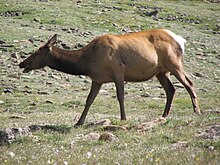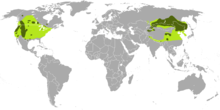Cervus canadensis
| Elk Temporal range: 2.5–0 Ma Early – Recent |
|
|---|---|
 |
|
| Elk (male) | |
 |
|
| Elk (female) | |
| Scientific classification | |
| Kingdom: | Animalia |
| Phylum: | Chordata |
| Class: | Mammalia |
| Order: | Artiodactyla |
| Suborder: | Ruminantia |
| Family: | Cervidae |
| Subfamily: | Cervinae |
| Genus: | Cervus |
| Species: | C. canadensis |
| Binomial name | |
|
Cervus canadensis (Erxleben, 1777) |
|
| Subspecies | |
 |
|
| Former (light green) and current (dark green) native ranges of Cervus canadensis | |
| Synonyms | |
|
Various Cervus elaphus subspecies |
|
Various Cervus elaphus subspecies
The elk, or wapiti (Cervus canadensis), is one of the largest species within the deer family, Cervidae, in the world, and one of the largest land mammals in North America and Eastern Asia. This animal should not be confused with the still larger moose (Alces alces) to which the name "elk" applies in British English and in reference to populations in Eurasia.
Elk range in forest and forest-edge habitat, feeding on grasses, plants, leaves, and bark. Male elk have large antlers which are shed each year. Males also engage in ritualized mating behaviors during the rut, including posturing, antler wrestling (sparring), and bugling, a loud series of vocalizations that establishes dominance over other males and attracts females.
Although they are native to North America and eastern Asia, they have adapted well to countries in which they have been introduced, including Argentina and New Zealand. Their great adaptability may threaten endemic species and ecosystems into which they have been introduced.
Elk are susceptible to a number of infectious diseases, some of which can be transmitted to livestock. Efforts to eliminate infectious diseases from elk populations, largely by vaccination, have had mixed success.
Some cultures revere the elk as a spiritual force. In parts of Asia, antlers and their velvet are used in traditional medicines. Elk are hunted as a game species. The meat is leaner and higher in protein than beef or chicken.
...
Wikipedia

